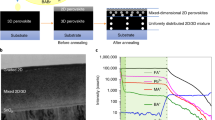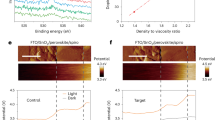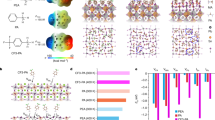Abstract
The open-circuit voltage (VOC) deficit in perovskite solar cells is greater in wide-bandgap (over 1.7 eV) cells than in perovskites of roughly 1.5 eV (refs. 1,2). Quasi-Fermi-level-splitting measurements show VOC-limiting recombination at the electron-transport-layer contact3,4,5. This, we find, stems from inhomogeneous surface potential and poor perovskite–electron transport layer energetic alignment. Common monoammonium surface treatments fail to address this; as an alternative, we introduce diammonium molecules to modify perovskite surface states and achieve a more uniform spatial distribution of surface potential. Using 1,3-propane diammonium, quasi-Fermi-level splitting increases by 90 meV, enabling 1.79 eV perovskite solar cells with a certified 1.33 V VOC and over 19% power conversion efficiency (PCE). Incorporating this layer into a monolithic all-perovskite tandem, we report a record VOC of 2.19 V (89% of the detailed balance VOC limit) and over 27% PCE (26.3% certified quasi-steady state). These tandems retained more than 86% of their initial PCE after 500 h of operation.
This is a preview of subscription content, access via your institution
Access options
Access Nature and 54 other Nature Portfolio journals
Get Nature+, our best-value online-access subscription
$29.99 / 30 days
cancel any time
Subscribe to this journal
Receive 51 print issues and online access
$199.00 per year
only $3.90 per issue
Buy this article
- Purchase on Springer Link
- Instant access to full article PDF
Prices may be subject to local taxes which are calculated during checkout




Similar content being viewed by others
Data availability
All data are available in the main text or supplementary materials. The data that support the findings of this study are available from the corresponding authors on reasonable request.
Code availability
The code that supports the findings of this study is available from the corresponding authors on reasonable request.
Change history
24 July 2023
A Correction to this paper has been published: https://doi.org/10.1038/s41586-023-06450-5
References
Oliver, R. D. J. et al. Understanding and suppressing non-radiative losses in methylammonium-free wide-bandgap perovskite solar cells. Energy Environ. Sci. 15, 714–726 (2022).
Mahesh, S. et al. Revealing the origin of voltage loss in mixed-halide perovskite solar cells. Energy Environ. Sci. 13, 258–267 (2020).
Stranks, S. D., Hoye, R. L. Z., Di, D., Friend, R. H. & Deschler, F. The physics of light emission in halide perovskite devices. Adv. Mater. 31, 1803336 (2019).
Stolterfoht, M. et al. Visualization and suppression of interfacial recombination for high-efficiency large-area pin perovskite solar cells. Nat. Energy 3, 847–854 (2018).
Warby, J. et al. Understanding performance limiting interfacial recombination in pin perovskite solar cells. Adv. Energy Mater. 12, 2103567 (2022).
Wang, R. et al. Prospects for metal halide perovskite-based tandem solar cells. Nat. Photon. 15, 411–425 (2021).
Leijtens, T., Bush, K. A., Prasanna, R. & McGehee, M. D. Opportunities and challenges for tandem solar cells using metal halide perovskite semiconductors. Nat. Energy 3, 828–838 (2018).
Al-Ashouri, A. et al. Monolithic perovskite/silicon tandem solar cell with >29% efficiency by enhanced hole extraction. Science 370, 1300–1309 (2020).
Chen, W. et al. Monolithic perovskite/organic tandem solar cells with 23.6% efficiency enabled by reduced voltage losses and optimized interconnecting layer. Nat. Energy 7, 229–237 (2022).
Lin, R. et al. All-perovskite tandem solar cells with improved grain surface passivation. Nature 603, 73–78 (2022).
NREL. Best research-cell efficiency chart. https://www.nrel.gov/pv/cell-efficiency.html (accessed 21 November 2022).
Jeong, M. et al. Stable perovskite solar cells with efficiency exceeding 24.8% and 0.3-V voltage loss. Science 369, 1615–1620 (2020).
Zhang, J. et al. Intermediate phase enhances inorganic perovskite and metal oxide interface for efficient photovoltaics. Joule 4, 222–234 (2020).
Liu, Z., Siekmann, J., Klingebiel, B., Rau, U. & Kirchartz, T. Interface optimization via fullerene blends enables open-circuit voltages of 1.35 V in CH3NH3Pb(I0.8Br0.2)3 solar cells. Adv. Energy Mater. 11, 2003386 (2021).
Tong, J. et al. Wide-bandgap metal halide perovskites for tandem solar cells. ACS Energy Lett. 6, 232–248 (2021).
Stolterfoht, M. et al. The impact of energy alignment and interfacial recombination on the internal and external open-circuit voltage of perovskite solar cells. Energy Environ. Sci. 12, 2778–2788 (2019).
Zhao, T., Chueh, C. C., Chen, Q., Rajagopal, A. & Jen, A. K. Y. Defect passivation of organic-inorganic hybrid perovskites by diammonium iodide toward high-performance photovoltaic devices. ACS Energy Lett. 1, 757–763 (2016).
Ross, R. T. Some thermodynamics of photochemical systems. J. Chem. Phys. 46, 4590 (2004).
Teale, S. et al. Dimensional mixing increases the efficiency of 2D/3D perovskite solar cells. J. Phys. Chem. Lett. 11, 5115–5119 (2020).
Yang, S. et al. Stabilizing halide perovskite surfaces for solar cell operation with wide-bandgap lead oxysalts. Science 365, 473–478 (2019).
Jiang, Q. et al. Surface passivation of perovskite film for efficient solar cells. Nat. Photon. 13, 460–466 (2019).
Chen, H. et al. Quantum-size-tuned heterostructures enable efficient and stable inverted perovskite solar cells. Nat. Photon. 16, 352–358 (2022).
Aber, A. G., Glunz, S. & Warta, W. Field effect passivation of high efficiency silicon solar cells. Sol. Energy Mater. Sol. Cells 29, 175–182 (1993).
Jang, Y. W. et al. Intact 2D/3D halide junction perovskite solar cells via solid-phase in-plane growth. Nat. Energy 6, 63–71 (2021).
Wu, W. Q. et al. Bilateral alkylamine for suppressing charge recombination and improving stability in blade-coated perovskite solar cells. Sci. Adv. 5, eaav8925 (2019).
Kapil, G. et al. Tin-lead perovskite fabricated via ethylenediamine interlayer guides to the solar cell efficiency of 21.74%. Adv. Energy Mater. 11, 2101069 (2021).
Hu, S. et al. Optimized carrier extraction at interfaces for 23.6% efficient tin–lead perovskite solar cells. Energy Environ. Sci. 15, 2096–2107 (2022).
Frohna, K. et al. Nanoscale chemical heterogeneity dominates the optoelectronic response of alloyed perovskite solar cells. Nat. Nanotechnol. 17, 190–196 (2021).
Baldo, M. A. & Forrest, S. R. Interface-limited injection in amorphous organic semiconductors. Phys. Rev. B 64, 085201 (2001).
Saidaminov, M. I. et al. Multi-cation perovskites prevent carrier reflection from grain surfaces. Nat. Mater. 19, 412–418 (2020).
Li, Z. et al. Organometallic-functionalized interfaces for highly efficient inverted perovskite solar cells. Science 376, 416–420 (2022).
Zhang, F. et al. Metastable Dion-Jacobson 2D structure enables efficient and stable perovskite solar cells. Science 375, 71–76 (2022).
Zhang, L. et al. Surface defect passivation of pb–sn-alloyed perovskite film by 1,3-propanediammonium iodide toward high-performance photovoltaic devices. Sol. RRL 5, 2100299 (2021).
Zhang, F. et al. Surface lattice engineering through three-dimensional lead iodide perovskitoid for high-performance perovskite solar cells. Chem 7, 774–785 (2021).
Park, B. et al. Understanding how excess lead iodide precursor improves halide perovskite solar cell performance. Nat. Commun. 9, 3301 (2018).
Yan, N. et al. Ligand-anchoring-induced oriented crystal growth for high-efficiency lead-tin perovskite solar cells. Adv. Funct. Mater. 32, 2201384 (2022).
Chiara, R. et al. The templating effect of diammonium cations on the structural and optical properties of lead bromide perovskites: a guide to design broad light emitters. J. Mater. Chem. C Mater. 10, 12367 (2022).
Eperon, G. E. et al. Formamidinium lead trihalide: a broadly tunable perovskite for efficient planar heterojunction solar cells. Energy Environ. Sci. 7, 982–988 (2014).
Zheng, X. et al. Defect passivation in hybrid perovskite solar cells using quaternary ammonium halide anions and cations. Nat. Energy 2, 17102 (2017).
Stolterfoht, M. et al. How to quantify the efficiency potential of neat perovskite films: perovskite semiconductors with an implied efficiency exceeding 28%. Adv. Mater. 32, 2000080 (2020).
Tong, J. et al. Carrier lifetimes of >1 ms in Sn-Pb perovskites enable efficient all-perovskite tandem solar cells. Science 364, 475–479 (2019).
Lin, R. et al. Monolithic all-perovskite tandem solar cells with 24.8% efficiency exploiting comproportionation to suppress Sn(ii) oxidation in precursor ink. Nat. Energy 4, 864–873 (2019).
Xiao, K. et al. All-perovskite tandem solar cells with 24.2% certified efficiency and area over 1 cm2 using surface-anchoring zwitterionic antioxidant. Nat. Energy 5, 870–880 (2020).
Wen, J. et al. Steric engineering enables efficient and photostable wide-bandgap perovskites for all-perovskite tandem solar cells. Adv. Mater. 34, 2110356 (2022).
Song, T., Freidman, D. J. & Kopidakis, N. How useful are conventional I–Vs for performance calibration of single- and two-junction perovskite solar cells? A statistical analysis of performance data on ≈200 cells from 30 global sources. Sol. RRL 6, 2100867 (2022).
Chen, H. et al. Efficient and stable inverted perovskite solar cells incorporating secondary amines. Adv. Mater. 31, 1903559 (2019).
Ilavsky, J. Nika: software for two-dimensional data reduction. J. Appl. Crystallogr. 45, 324–328 (2012).
Jiang, Z. GIXSGUI: a MATLAB toolbox for grazing-incidence X-ray scattering data visualization and reduction, and indexing of buried three-dimensional periodic nanostructured films. J. Appl. Crystallogr. 48, 917–926 (2015).
Burgelman, M., Nollet, P. & Degrave, S. Modelling polycrystalline semiconductor solar cells. Thin Solid Films 361–362, 527–532 (2000).
Shao, Y., Yuan, Y. & Huang, J. Correlation of energy disorder and open-circuit voltage in hybrid perovskite solar cells. Nat. Energy 1, 15001 (2016).
Aydin, E. et al. Ligand-bridged charge extraction and enhanced quantum efficiency enable efficient n–i–p perovskite/silicon tandem solar cells. Energy Environ. Sci. 14, 4377–4390 (2021).
Delamarre, A., Lombez, L. & Guillemoles, J. F. Characterization of solar cells using electroluminescence and photoluminescence hyperspectral images. J. Photonics Energy 2, 027004 (2012).
Rau, U. Reciprocity relation between photovoltaic quantum efficiency and electroluminescent emission of solar cells. Phys. Rev. B Condens. Matter Mater. Phys. 76, 085303 (2007).
Wurfel, P. The chemical potential of radiation. J. Phys. C Solid State Phys. 15, 3967–3985 (1982).
El-Hajje, G. et al. Quantification of spatial inhomogeneity in perovskite solar cells by hyperspectral luminescence imaging. Energy Environ. Sci. 9, 2286–2294 (2016).
Wurfel, P., Finkbeiner, S. & Daub, E. Generalized Planck’s radiation law for luminescence via indirect transitions. Appl. Phys. A 60, 67–70 (1995).
Ren, X. et al. Resolution-of-identity approach to Hartree–Fock, hybrid density functionals, RPA, MP2 and GW with numeric atom-centered orbital basis functions. New J. Phys. 14, 053020 (2012).
Havu, V., Blum, V., Havu, P. & Scheffler, M. Efficient O(N) integration for all-electron electronic structure calculation using numeric basis functions. J. Comput. Phys. 228, 8367–8379 (2009).
Blum, V. et al. Ab initio molecular simulations with numeric atom-centered orbitals. Comput. Phys. Commun. 180, 2175–2196 (2009).
Perdew, J. P., Burke, K. & Ernzerhof, M. Generalized gradient approximation made simple. Phys. Rev. Lett 77, 3865–3868 (1996).
Tkatchenko, A. & Scheffler, M. Accurate molecular van der Waals interactions from ground-state electron density and free-atom reference data. Phys. Rev. Lett. 102, 073005 (2009).
Huhn, W. P. & Blum, V. One-hundred-three compound band-structure benchmark of post-self-consistent spin-orbit coupling treatments in density functional theory. Phys. Rev. Mater. 1, 033803 (2017).
Acknowledgements
We thank J. Warby for a useful discussion that contributed to our understanding of perovskite–ETL interfaces, and T. Song and N. Kopidakis at NREL for device certification. Z.W. acknowledges the Banting Postdoctoral Fellowships Program of Canada. GIWAXS patterns were collected at the BXDS-WLE Beamline at CLS with the assistance of C.-Y. Kim and A. Leontowich. This research was made possible by the US Department of the Navy, Office of Naval Research (grant nos. N00014-20-1-2572 and N00014-20-1-2725) and the US Department of Energy’s Office of Energy Efficiency and Renewable Energy under Solar Energy Technologies Office Award no. DE-EE0008753. This work was supported in part by the Ontario Research Fund Research Excellence programme (ORF7: Ministry of Research and Innovation, Ontario Research Fund-Research Excellence Round 7). This work was also supported by the King Abdullah University of Science and Technology under award no. OSR-CRG2020-4350. This work was authored in part by the National Renewable Energy Laboratory, operated by Alliance for Sustainable Energy for the US Department of Energy under contract no. DE-AC36-08GO28308. NREL authors acknowledge support from the Operational Energy Capability Improvement Fund of the Department of Defense. The views expressed in the article do not necessarily represent the views of the Department of Energy or the US Government. CLS is funded by NSERC, the Canadian Institutes of Health Research, CFI, the Government of Saskatchewan, Western Economic Diversification Canada and the University of Saskatchewan. This work was also supported by the Natural Sciences and Engineering Council of Canada and the Vanier Canada Graduate Scholarship.
Author information
Authors and Affiliations
Contributions
H.C., A.M., S.T. and B.C. planned experiments and coordinated the work. H.C. fabricated WBG devices and tandems for performance and certification and fabricated perovskite films for characterization. H.C., A.M., C. Li and L.C. fabricated NBG devices and tandems. S.T. and A.M. wrote the original draft. S.T., B.C., E.U. and S.D.W. carried out optical spectroscopy of films and devices and performed data analysis. T.Z. carried out DFT calculations. G.H. and S.D.W. performed UPS measurements and data analysis. P.S. and T.F. carried out KPFM and data analysis. S.T. and L.G. performed GIWAXS measurements and analysed data. J.W., Z.W., L.Z., S.M.P. and L.G. helped optimize the single-junction and tandem device structure. R.A.A. conducted thermal admittance spectroscopy measurements. X.Z., J.M.L., C.X., B.S., C. Liu, Y. Yang, M.G.K. and N.J.P. assisted with device analysis and data interpretation. E.H.S., Y. Yan, S.D.W. and M.G.K. secured funding and helped to review and edit the manuscript.
Corresponding authors
Ethics declarations
Competing interests
The authors declare no competing interests.
Peer review
Peer review information
Nature thanks Weijun Ke and the other, anonymous, reviewer(s) for their contribution to the peer review of this work. Peer reviewer reports are available.
Additional information
Publisher’s note Springer Nature remains neutral with regard to jurisdictional claims in published maps and institutional affiliations.
Supplementary information
Supplementary Information
Supplementary Figs. 1–24, Tables 1–4, Notes 1 and 2 and references.
Rights and permissions
Springer Nature or its licensor (e.g. a society or other partner) holds exclusive rights to this article under a publishing agreement with the author(s) or other rightsholder(s); author self-archiving of the accepted manuscript version of this article is solely governed by the terms of such publishing agreement and applicable law.
About this article
Cite this article
Chen, H., Maxwell, A., Li, C. et al. Regulating surface potential maximizes voltage in all-perovskite tandems. Nature 613, 676–681 (2023). https://doi.org/10.1038/s41586-022-05541-z
Received:
Accepted:
Published:
Issue Date:
DOI: https://doi.org/10.1038/s41586-022-05541-z
This article is cited by
-
Double-side 2D/3D heterojunctions for inverted perovskite solar cells
Nature (2024)
-
Inhibition of halide oxidation and deprotonation of organic cations with dimethylammonium formate for air-processed p–i–n perovskite solar cells
Nature Energy (2024)
-
Silver telluride colloidal quantum dot infrared photodetectors and image sensors
Nature Photonics (2024)
-
Harnessing strong aromatic conjugation in low-dimensional perovskite heterojunctions for high-performance photovoltaic devices
Nature Communications (2024)
-
Enhancing the efficiency and longevity of inverted perovskite solar cells with antimony-doped tin oxides
Nature Energy (2024)
Comments
By submitting a comment you agree to abide by our Terms and Community Guidelines. If you find something abusive or that does not comply with our terms or guidelines please flag it as inappropriate.



